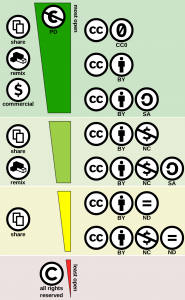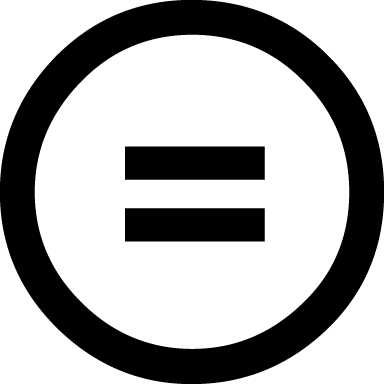Open licenses
Using open licenses is a crucial aspect of open access. Open licenses are a set of conditions applied to a work that grant permission for anyone to make use of that work as long as they follow the conditions of the license. In other words, an open license defines how others are allowed to reuse a work. A work refers to an original creation, such as a research paper, video, or song that can be copyright protected.
Different forms of reuse include distributing, adapting, and building upon a work. Open licenses make it possible for others to reuse the material legally, without having to find you to get permission. When your work is correctly attributed, it also helps others refer to you correctly.
The Creative Commons license system
CC BY - “attribution”: the most liberal of the CC licenses, allows the work to be distributed, modified, adapted, and built upon, also for commercial purposes. Requires re-users only to attribute the creator of the work (the author, the license, and the original publication address) and clearly indicate any modifications.
The latest version of CC BY is CC BY 4.0.
The CC BY license can be restricted by the following clauses:
- SA - "share alike": demanding that modified versions use the same license as the original work
- NC - "non-commercial": disallowing commercial use (if you use this clause, include contact information so that re-users can request separate permission for commercial use)
- ND - “no derivatives”: disallowing modification, tweaking, remixing (if you use this for an entire article, you also restrict the separation and reuse of diagrams or images included in it unless you license those items separately with a more liberal license)

More information:
- 5-minute introduction video to Creative Commons
- Outline of what the different CC-licenses permit
- Recommendations for best licensing practices
Considerations when choosing a license
CC BY
-
Maximum distribution and long-term preservation
-
Allows reuse for educational purposes and enables text mining
-
Provides sufficient protection of your rights as an author, as it demands re-users to indicate all modifications (the ND clause unnecessary)
-
Recommended by the cOAlition S consortium due to the above reasons
 SA
SA
-
The SA clause is often sufficient if you wish to restrict re-use in commercial works (the NC clause unnecessary). With the SA clause, anyone publishing modified versions of your article must publish their versions under the same CC-license, which doesn't encourage commercial activity.
 NC
NC
-
The NC clause may unnecessarily delimit the re-use of your work, as it is not always clear if a purpose is commercial or non-commercial.
-
The NC clause may restrict the right to share on academic social network services such as Research Gate as these services can be considered commercial.
-
If you haven’t given away the commercial use rights in a separate agreement, you can share your publication.
-
If you have given away these rights, for instance in a publishing agreement, your right to share depends on this agreement.
-
 ND
ND
-
Allows for very restricted re-use and should be applied only when highly motivated.
-
Licensing without the ND clause does not mean that others can edit your original article and thereby add their name to it, only that others can publish their own modified version of it. Moreover, any modified version must clearly delineate which part is copied from your article, and which are the modifications. The re-user’s version of your article is a new, non-peer-reviewed draft.
-
In theory, licensing without the ND clause allows for distortion of the work, as it can be freely adapted. However, other laws apply, which protects from distortion of research results. For lawful but inappropriate reuse scenarios, CC-licenses include clause 3(a)(3), under which the creator can demand for the removal of their name from a modified version.
How do I license my work?
When licensing a work, it's important to consider the following:"
- The license needs to be added to the work before publication. Once a work is published the license cannot be revoked or restricted, but it can be made less restrictive.
- In case several contributors are involved, all creators should agree on the choice of license.
- A CC-licensed research paper may contain material (diagrams, images, etc) provided with another license or user rights than the body of the paper. Similarly, articles in a collection can be licensed separately if needed. However, the digital and printed versions of an article cannot be licensed differently, they are covered by the same license.
- Publishers usually provide one or more license options. When publishing in a journal, you accept the publisher’s license policy. However, note that CC BY 4.0 is recommended for maximum dissemination. CC BY-SA 4.0 is also acceptable for scientific publications. Make sure that the journal you aim to publish in accepts and uses these licenses! Also, note that funders may require CC BY.
- In cases where you may choose the license yourself and need to add the license information to your material (e.g. a document or web page), use the License chooser to find the most suitable license for your work. Remember to include a link to your ORCID profile in the field “Link to Creator Profile”. Then copy the license information, including the link to the license deed, and add it to your work.
|
|
Example format: Why open access? - a scoping review © 2024 by John Doe is licensed under CC BY-SA 4.0
FAQ
Can a CC-licensed article cite material that is not CC-licensed?
Yes.
Can I share my CC-licensed article on an academic social network (ASN) service such as ResearchGate?
The license alternatives that can restrict the right to share on ASN are those containing the NC clause. However, if you haven’t given away the commercial use rights in a separate agreement, you can share the publication. If you have given away these rights, for instance in a publishing agreement, your right to share depends on this agreement. Remember to ask your co-authors for the right to share on ASN.
Can I share someone else’s CC-licensed article on an academic social network (ASN) service such as ResearchGate?
The license alternatives that can restrict the right to share on ASN are those containing the NC clause. Sharing others’ work on ASN is problematic as such services are considered commercial. Therefore, it's recommended not to share other’s work on them.
Can I license the digital and printed versions of an article differently?
No. The digital and printed versions of an article are covered by the same license.
If I don't want anyone to use my article in commercial works, should I choose a CC license that includes the NC clause?
Often, an SA clause is sufficient. In this case, anyone publishing modified versions of your article must publish their versions under the same CC license, which doesn't encourage commercial activity.
If I license my publication without an ND clause, can anyone edit my article on the journal's website, like on Wikipedia?
No. Others would have the right to publish a modified version of your article on their own websites, but the original article would remain untouched. Furthermore, any modified version must clearly delineate which part is copied from your article, and which are the modifications.
If I license my publication without an ND clause, can a re-user make cosmetic changes to it, and then add their name alongside mine as an author?
No. CC-licensing doesn't alter the practices of scientific publishing, peer review, or ethical guidelines prohibiting plagiarism. The re-user’s version of your article is a new, non-peer-reviewed draft. Furthermore, any modified version must clearly delineate which part is copied from your article, and which are the modifications.
If I license my publication without an ND clause, can my text end up in a distorted or inappropriate form?
Indeed, CC-licensed articles can be adapted, so from a copyright perspective, this cannot be prevented. However, other laws apply, which protects from distortion of research results. For lawful but inappropriate reuse scenarios, CC-licenses include clause 3(a)(3), under which the creator can demand for the removal of their name from a modified version.
Should I license individual articles in a collection separately or use the same license for the entire publication?
If all articles are licensed under the same CC license, the same license can be used for the entire publication. If the publication contains material with different licenses, licensing the entire publication is often impractical and licensing the articles separately is preferable.
This guide by Åbo Akademi University Library is licensed under CC BY 4.0 

